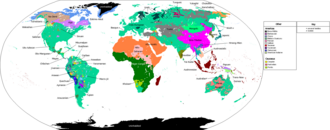
This is a list of languages by total number of speakers.
It is difficult to define what constitutes a language as opposed to a dialect. For example, Chinese and Arabic are sometimes considered single languages, but each includes several mutually unintelligible varieties, and so they are sometimes considered language families instead. Conversely, colloquial registers of Hindi and Urdu are almost completely mutually intelligible, and are sometimes classified as one language, Hindustani. Such rankings should be used with caution, because it is not possible to devise a coherent set of linguistic criteria for distinguishing languages in a dialect continuum.[1]
There is no single criterion for how much knowledge is sufficient to be counted as a second-language speaker. For example, English has about 450 million native speakers but, depending on the criterion chosen, can be said to have as many as two billion speakers.[2]
There are also difficulties in obtaining reliable counts of speakers, which vary over time because of population change and language shift. In some areas, there is no reliable census data, the data is not current, or the census may not record languages spoken, or record them ambiguously. Sometimes speaker populations are exaggerated for political reasons, or speakers of minority languages may be underreported in favor of a national language.[3]
Ethnologue lists the following languages as having 50 million or more total speakers.[4] This section does not include entries that Ethnologue identifies as macrolanguages encompassing several varieties, such as Arabic, Lahnda, Persian, Malay, Pashto, and Chinese.
The World Factbook, produced by the Central Intelligence Agency (CIA), estimates the ten most spoken languages (L1 + L2) in 2022 as follows:[6]